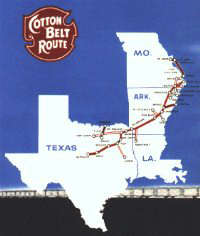Tyler Tap Railroad
The actual construction eventually began some time in the summer of 1875, as Douglas reported the completion of ten miles of grading on August 30 of that year. The route was surveyed through a rolling landscape, following the creek beds in an effort to reduce the grade as much as possible. The longest grade encountered was 5700 feet, the shortest 100 feet, and the average usually 1500 feet. For every 100-foot rise, the grade ranged between 0.2 and 1.75 per cent. The ratio of curvature was large in comparison to the total length of the roadbed, but was as small as the natural difficulties would allow. The engineering expenses amounted to about $2,025.
One year later, in 1876, the grading was completed to one mile north of Sandy Switch (now Big Sandy, Texas), a station on the Texas and Pacific Railroad, in Upshur County, making a little over twenty two miles in length. Another road gang had graded from Mt. Pleasant to Station 903,

which was four and one-half miles south of Pittsburg. This gap was eventually filled in, making a continuous roadbed between Mt. Pleasant and Tyler, Texas.
At this particular time the gauge to be used was in doubt. The charter stipulated that the company use the same gauge as the road with which it was to connect, which was the standard gauge of Texas and Pacific. Although $3,000,000 had been authorized for the capital stock, less than $50,000 in shares were sold, making it necessary to consider seriously a narrow gauge. As late as December, 1876, it was reported that the gauge was not definitely decided. The first mortgage, secured by twenty-year, seven per cent gold bonds, dated March 1, 1877, authorized the value of the road at $7,000 per mile. Eventually, financial difficulties determined that a three-foot gauge would be more in proportion to the money available.
The actual date the road was put into operation, according to Poor's Railroad Manual of 1878, was October 1, 1877. In that year General U. S. Grant had stepped down and Rutherford B. Hayes had just been inaugurated president of the United States. Alexander Graham Bell only a year before had invented a device called the telephone. The Civil War had ended and Abraham Lincoln had been assassinated only a dozen years prior. The South was in the grip of a great depression.
There was only one mile of siding and yard track, which was enough to operate the limited equipment. This equipment included one passenger car and sixteen freight cars. The passenger train schedule called for a round trip each day, as there was no provision made to run at night. The motive power consisted Of one locomotive named "Governor Hubbard", after the distinguished and personal friend of Major Douglas. This, however, is contradictory to legend, according to which there were two diminutive locomotives, "Punch" and "Judy" and, literally speaking both were the pride and joy of the local countryside. The other evidence to discredit this belief is the last financial statement of the railroad printed in Poor's Railroad Manual of 1878, which lists only one locomotive. Tradition also insists that wooden rails were originally used, but it is now well established that iron rails weighing between thirty and thirty-five pounds laid on new cross ties constituted the first track.
